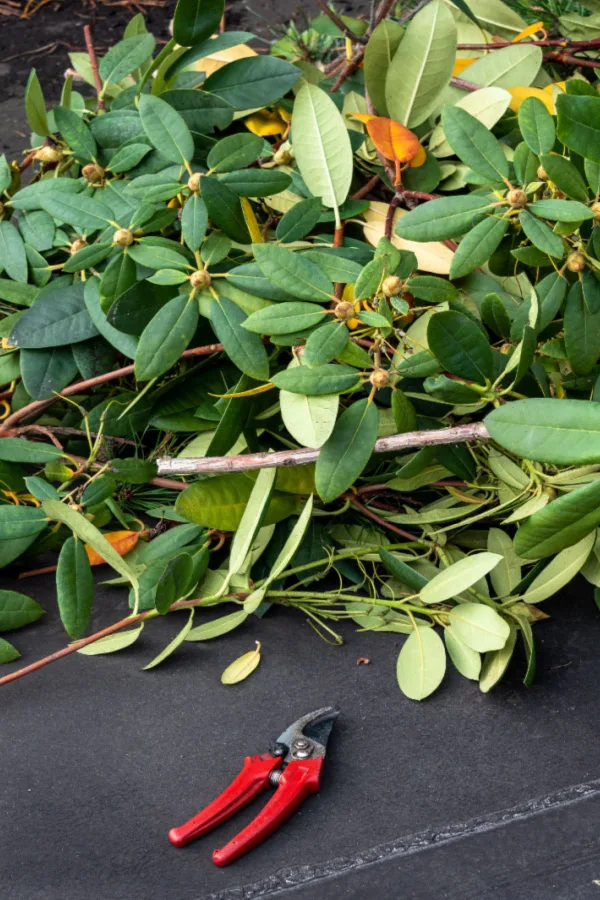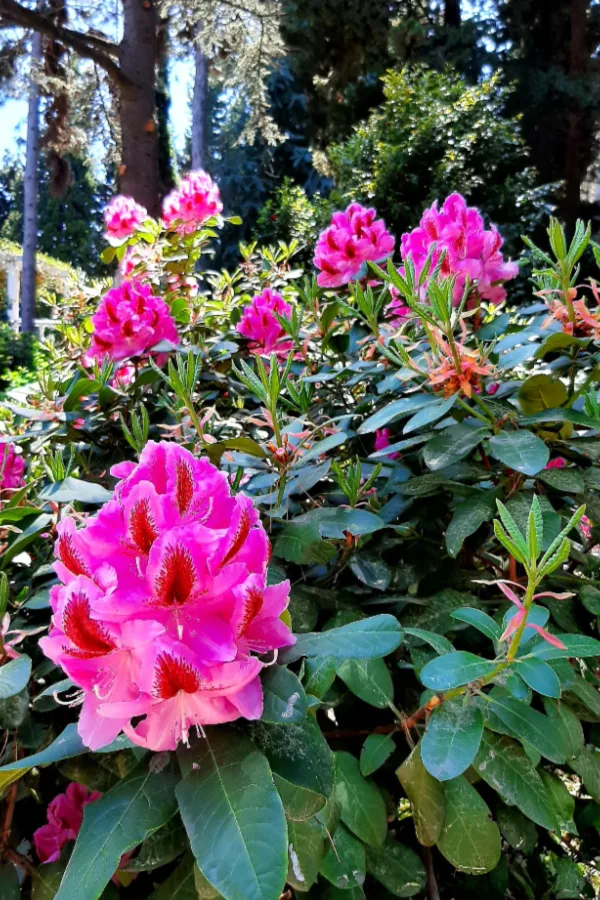Winter is just around the corner, and that means it’s time to for a little fall rhododendron care to get your bushes ready to bloom bigger than ever next year!
Rhododendrons, along with hydrangeas and peonies, are one of the three most popular blooming bushes to plant and grow in the home landscape. With their deep, dark green foliage that can often stay in place all winter long, they certainly are perfect for adding four season interest.
But when it comes to getting these hardy perennials to bloom consistently and strong each and every year, the bush can be a bit finicky for many gardeners. And believe it or not, it’s often the care it does or doesn’t receive in the fall that can be the problem!
To bloom consistently and in full force rhododendrons have two major key requirements. First, they need to grow in a location that receive more shade than sun. In addition, like their relative the azalea, they also need to grow in soil that not only drains well, but leans more to the acidic side when it comes to its pH.
But if those two needs are met – and your rhododendron still isn’t blooming – it’s most likely the care they are getting or not getting during the autumn months that is to blame. With that in mind, here is a look at how to give your rhododendrons the perfect dose of TLC this fall!
How To Care For Rhododendrons In The Fall
The good news is that fall care is actually quite simple when it comes to rhododendrons. In fact, more problems arrive when gardeners do too much to their bushes in the early autumn than not enough. Especially when it comes to pruning!
Avoiding Fall Pruning
When it comes to fall rhododendron chores, one task you can cross off your to-do list is pruning. It simply puts too much stress on the plant. Even worse, it leaves it in danger of winter damage.

Pruning rhododendrons in the fall is actually one of the major causes of the perennial failing to bloom the following year. For starters, pruning forces the plant to use resources and energy to heal. Power that should instead be stored to use the following year to help set blooms and flower.
Even more, pruning encourages new growth. And if the temperatures are warm enough in the fall to allow for new growth, the tender new shoots can easily be damaged once the harsh winter sets in. And just as with pruning, the plant once again has to spend precious resources healing damage.
It’s also important to realize that rhododendrons do not require a lot of pruning at any point of the season to continue blooming. Unlike many other perennials where pruning back can help promote more blooms, rhododendrons simply don’t need to be cut back except for keeping their shape.
If you do need to remove a bit of growth, it’s best to wait until early spring. It is then when all danger of freezing is past. In addition, the plant also has a full season of growth to heal and recover.
Fall Watering – How To Care For Rhododendrons In The Fall
One thing you can do for your rhododendron in the fall is make sure it gets plenty of hydration. Rhododendrons require a lot of water to produce their blooms and flower. That water is especially important during the autumn months as the bush prepares for winter – and starts to store energy for next year’s blooms.
Unfortunately, these big perennial bushes are often an afterthought when it comes to watering. Especially in the fall when a rhododendron’s blooms are long gone. But the often dry, less humid conditions fall can bring can quickly dry out the soil. And if the roots become too dry – next year’s blooms are sure to suffer.

Rhododendrons need 1 to 1.5 inches of water per week. If rain is not providing that to your plants – it’s time to water! The best way to water Rhododendrons is low and slow at the base of your bush. This allows the water to soak in slowly without run-off. Even better, it goes right to the roots where the plant needs it most.
Soaker hoses work great for watering rhododendrons. You can also simply turn on a hose at a very low setting and allow it to trickle in. Either way, the slower you water – the better! Product Affiliate Link : 10′ Soaker Hose
Fall Mulching – How To Care For Rhododendrons In The Fall
In addition to watering, applying a thick coat of mulch in the fall can also pay huge dividends for your rhododendrons.
Mulch is one of the best ways to help conserve moisture in the soil. It also helps control weeds that can compete for the same moisture and nutrients in the soil that your rhododendrons need. Finally, mulch also helps protect the soil and roots in the winter from constantly thawing and freezing.

Most perennials suffer more from rapid changes in the soil temperature in the winter than simply extreme cold. If the soil thaws and freezes constantly, it can create major issues for the plant. But if the temperature changes occur slowly, the plant has time to adjust. This is exactly where a thick coat of mulch helps!
A four to six inch layer of mulch is best to insulate the soil below. Instead of heating up or losing heat quickly, the mulch acts as insulation. This in turn slows the rapid changes in soil temperatures, protecting the plants in the process.
Apply mulch in mid to late fall while the soil is still warm. This will help the plant to slowly cool as late fall and winter temperatures drop.
Fertilizing – How To Care For Rhododendrons In The Fall
Last but not least, do not fertilize your rhododendrons in the fall. Much like pruning, fertilizing can spur new growth. Growth that is quite tender and can easily be injured by the upcoming winter.
Only fertilize rhododendrons in the spring, just as the buds begin to form on the bush. Always power your plants with fertilizer that is made for acid loving plants – this will ensure you are giving your rhododendrons exactly what they need to produce those big, beautiful blooms you love! Affiliate Product Link: Acid Loving Plant Food For Azaleas & Rhododendrons
So when it comes to fall care – remember, say no to pruning and fertilizing, and yes to water and mulch! It will have your rhododendrons blooming big year after year! Happy Gardening – Jim and Mary.
Jim and Mary Competti have been writing gardening, DIY and recipe articles and books for over 15 years from their 46 acre Ohio farm. The two are frequent speakers on all things gardening and love to travel in their spare time.
As always, feel free to email us at thefarm@owgarden.com with comments, questions, or to simply say hello! You can sign up for our free email list in the subscribe now box in the middle of this article. Follow us on Facebook here : OWG Facebook. This article may contain affiliate links.

